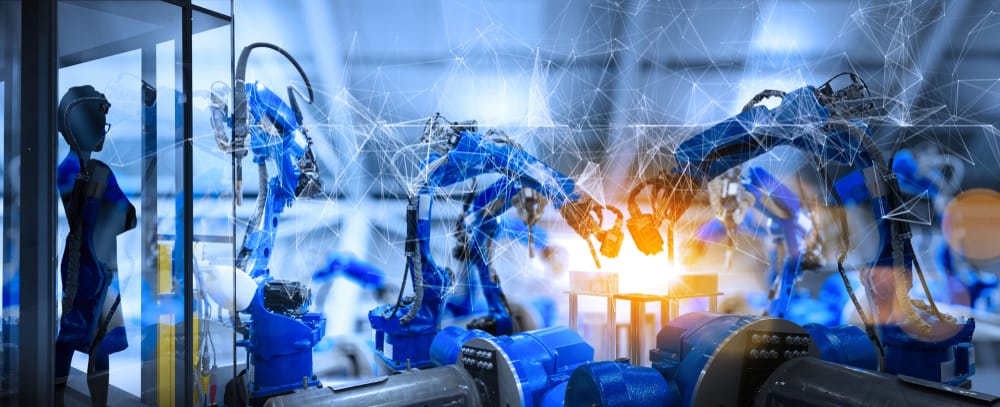
While industrial manufacturing processes have changed over the centuries, the core idea of industry remains the same: to manufacture products that make life easier. Throughout the history of manufacturing, radical ideas have periodically emerged to change the course of industry. For instance, in modern manufacturing, the first industrial revolution (Industry 1.0) marks a radical change in the use of machines. Likewise, the radical change in manufacturing that industries are adapting to today is known as smart manufacturing (Industry 5.0).
The evolution of Industry 1.0 to 5.0 holds both the history of modern manufacturing and future opportunities. In this article, we will review the history of industry and manufacturing, discuss the characteristics of modern industry, and examine what manufacturing may look like in the future.
Review of Manufacturing Evolution: Industry 1.0 to 5.0
The first industrial revolution (Industry 1.0) began in the 18th century and utilized steam and coal to mechanize manufacturing and greatly increase productivity. The second industrial revolution (Industry 2.0), which occurred in the latter part of the nineteenth century, introduced new electronic technologies into the industrial world. This enabled the rapid advance of innovations, such as assembly lines, which drastically reduced the time and cost involved in manufacturing.
Thanks to electronic innovations, digital technology emerged during the third industrial revolution (Industry 3.0). The introduction of an early computer, logic processors, and communication technologies (along with internet access) meant that the manufacturing could now be controlled and automated with even less human intervention. This also enabled the effective transition to the fourth industrial revolution (Industry 4.0).
Industry 4.0 offers a “smart” take on digital evolution. In today’s data-based industries, production floor data can be used to monitor and optimize efficiency. Integrating IoT (internet of Things) into the manufacturing process makes capturing and sharing vast amounts of data easier. As a result, manufacturers gain expanded insights into their current productivity and discover opportunities for improvement. Cloud-based computing facilitates faster data sharing and analysis to enable effective monitoring and performance analysis for operational improvements and cost reductions.
The next phase of the industrial revolution, Industry 5.0., focuses on integrating these mechanical and digital advances with Artificial Intelligence (AI) and Machine Learning (ML). With humans and robots working alongside each other, it is possible to leverage the precision, efficiency, and speed of automation with the creativity of the human mind.
What Does Industry 5.0 Look Like For Welding?
The progress of automation is evident in the welding industry with the wide use of orbital welding systems and auto weld heads. Recent trends also show the increasing use of integrated IoT with welding robots and programming software for welding productivity improvements. And with offline programming software, weld parameters can be optimized by the operator offline while the robot continues welding another application. This reduces welding downtime and increases efficiency.
While Industry 5.0 tries to establish a common working environment for humans and robots, it also enhances safety for operators by allowing robots to perform more challenging and hazardous welding tasks. This increases safety in overhead welding, welding in tight clearances, and in tasks where exposure to hazardous fumes is considerable.
With operators assuming more monitoring tasks, Industry 5.0 in welding can mean:
- Increased speed and productivity with robotics and automation
- Careful weld data sharing and analysis for process optimization
- Better ergonomics and safety for operators
- Fewer weld discrepancies with weld monitoring and visual data access
- Lower operating costs with increased welding precision and accuracy
Progress in the Welding Industry
Embracing Industry 5.0 means incorporating advanced machines, IoT technologies, and an array of smart devices compatible with today’s smart factories. In the welding industry, AMI facilitates this transition with a range of welding solutions compatible with IoT technologies for data capture and analysis.
Orbital welding equipment—including a power supply system, auto weld heads, and monitoring system supported with programming software—can easily blend the power of automation and remote parameter optimization for improved precision and productivity. Additionally, cloud data platforms enable faster storage and data sharing for more robust performance analysis. By enhancing the quality of work while ensuring operator safety, the welding industry can set another benchmark in precision welding for high-specification applications.
Arc Machines, Inc. is an industry leader in advanced orbital welding solutions that support a variety of manufacturing applications by applying and extending the progress made from Industry 1.0 to 5.0. To know more about our smart welding solutions, contact sales@arcmachines.com. For service inquiries, contact service@arcmachines.com. To develop a custom solution, contact us to arrange a meeting.




